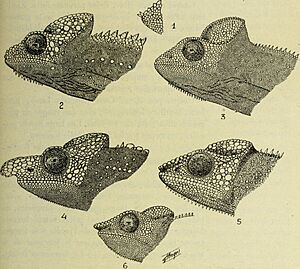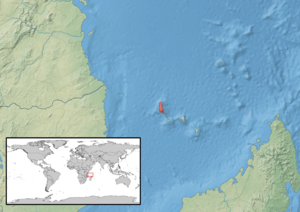Furcifer cephalolepis facts for kids
Quick facts for kids Furcifer cephalolepis |
|
|---|---|
 |
|
| Furcifer cephalolepis (illustration 1 at top, only showing nose) | |
| Conservation status | |
| Scientific classification | |
| Genus: |
Furcifer
|
| Species: |
cephalolepis
|
 |
|
| Synonyms | |
|
|
The Furcifer cephalolepis is a special kind of chameleon. It lives only on the island of Grande Comore. This island is part of the Comoros Islands. A scientist named Günther first described this chameleon in 1880.
The International Union for Conservation of Nature (IUCN) has listed this chameleon as "Least Concern". This means it is not currently in danger of disappearing. Even though many of these chameleons are sold as pets, their numbers seem to be stable.
Contents
Where Does This Chameleon Live?
The Furcifer cephalolepis chameleon is found only on Grande Comore. This island is also known as Ngazidja. It is part of the Comoros Islands. Scientists believe this chameleon lives all over the island. Grande Comore is about 1,146 square kilometers (442 square miles) in size.
Why It's Not Endangered
The International Union for Conservation of Nature (IUCN) has looked at this chameleon. They put it on their Red List of Threatened Species. It is listed as "Least Concern" (LC). This means its population is not shrinking. Even though it lives in a small area, its numbers are stable.
Where They Like to Live
These chameleons prefer places that are humid. You can find them near the coast of Grande Comore. They also live in forests, even those close to towns. They like areas with lots of plants and moisture.
Chameleons as Pets
Many Furcifer cephalolepis chameleons are sold as pets. Between 1994 and 2003, about 7,150 were exported. From 2004 to 2008, about 8,583 living chameleons were sent out. These chameleons were all from Grande Comore. The number of chameleons sold as pets is now controlled. This helps protect the wild population.
How Scientists Named This Chameleon
Scientists give every animal a special name. This helps everyone know exactly which animal they are talking about. The Furcifer cephalolepis was first named by Günther in 1880. He called it Chamaeleon cephalolepis.
Later, in 1999, another scientist named Necas changed its name. He renamed it Furcifer cephalolepis. Scientists sometimes change names as they learn more about animals.


